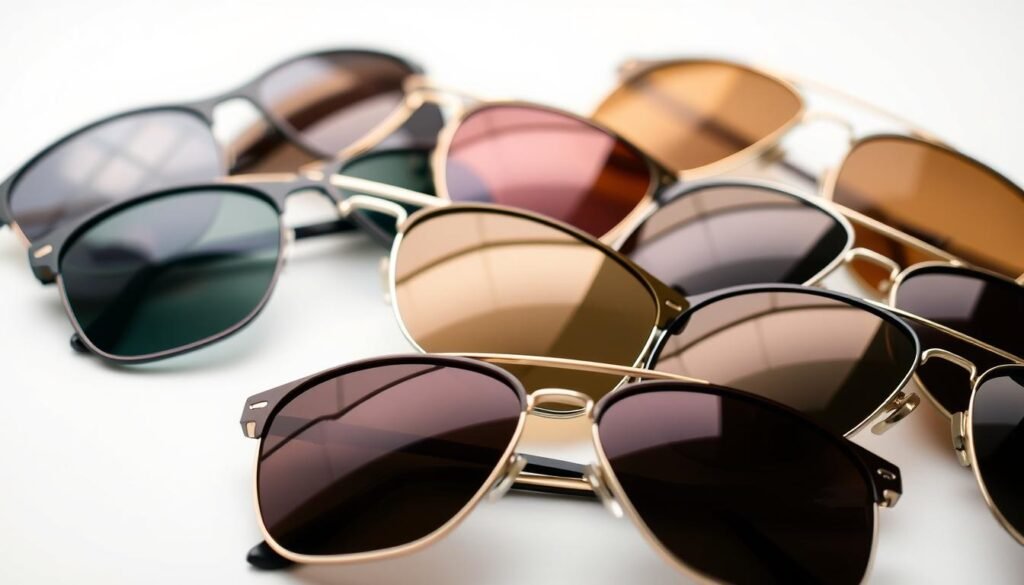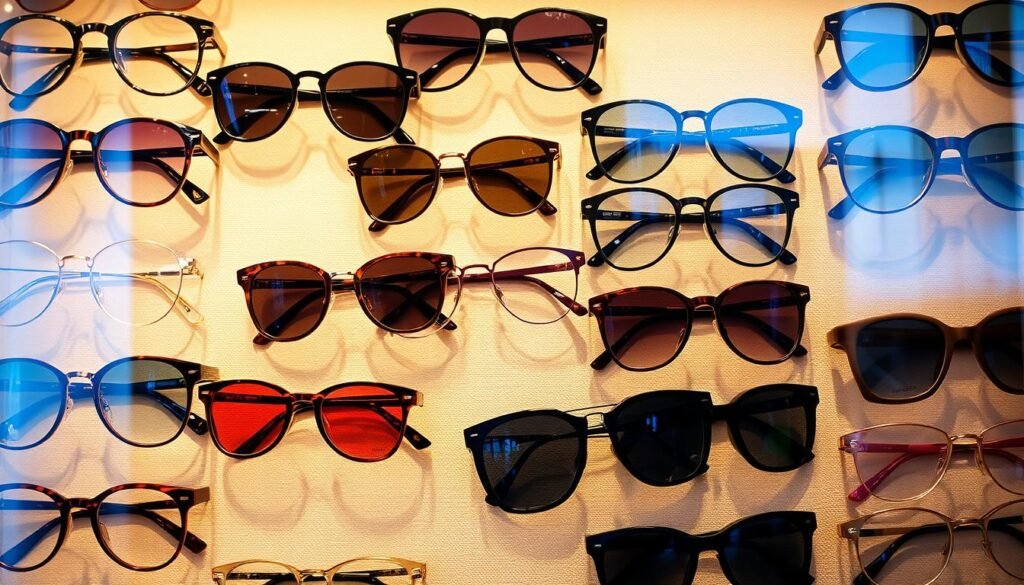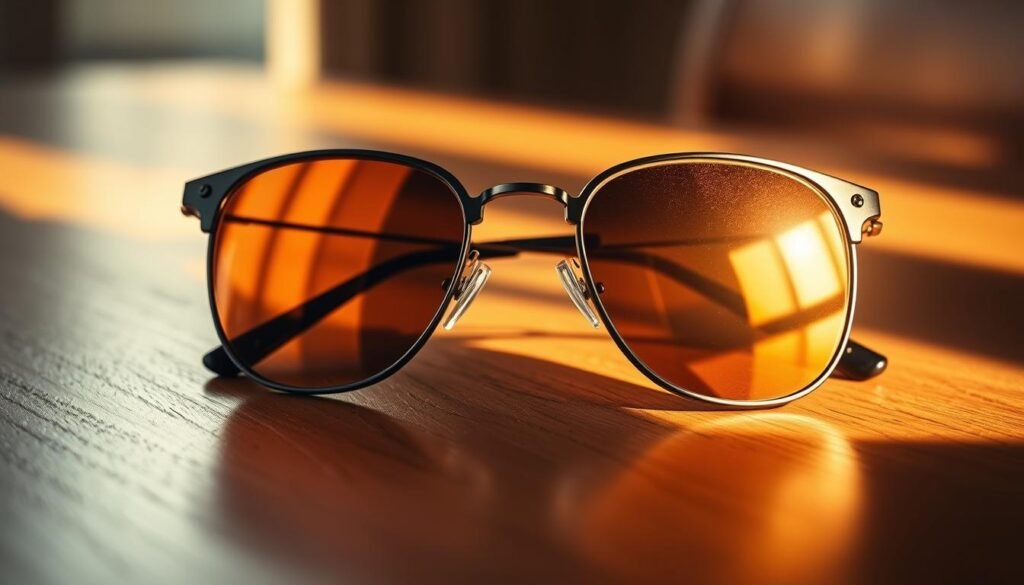Welcome to your go-to guide for finding eyewear that protects your eyes while elevating your look. While sunglasses are a summer staple, their role goes beyond fashion. They’re your first defense against UV rays, glare, and windblown debris—keeping your vision sharp and healthy.
Did you know modern shades evolved from 1920s pilot goggles? Hollywood icons like Audrey Hepburn transformed them into style icons by the 1960s. Today, they blend medical-grade protection with runway-ready designs.
This guide breaks down what matters most. We’ll explore how UV-blocking lenses prevent long-term eye damage, why frame shapes affect coverage, and which materials suit active lifestyles. You’ll also learn to match tints to activities—like amber lenses for driving or mirrored options for snowy slopes.
Key Takeaways
- UV protection is non-negotiable for eye health
- Frame size and shape determine coverage and comfort
- Lens materials like polycarbonate offer durability
- Style should complement your face shape and wardrobe
- Activity-specific features enhance performance
- Modern designs merge safety with trendsetting looks
Ready to ditch one-size-fits-all advice? Let’s find eyewear that works as hard as you do—this season and beyond.
Understanding the Benefits of Quality Sunglasses
Your eyes work tirelessly—quality eyewear returns the favor. Beyond fashion statements, UV-blocking lenses act as invisible bodyguards against solar radiation. Let’s explore how proper coverage preserves vision and comfort.
Shielding Against Silent Threats
Ultraviolet rays damage more than skin. Prolonged exposure contributes to:
- Cataract formation (cloudy eye lenses)
- Macular degeneration (central vision loss)
- Ocular melanoma (rare eye cancer)
Photokeratitis—think sunburned corneas—causes temporary blindness. Quality protection blocks 100% of UVA/UVB rays, acting like sunscreen for your retinas.
| Lens Type | UV Blocking | Glare Reduction | Best For |
|---|---|---|---|
| Polarized | 100% | High | Driving, fishing |
| Mirrored | 100% | Extreme | Snow sports |
| Solid Color | 100% | Medium | Daily urban use |
Comfort Through Light Control
Bright conditions force pupils to shrink constantly. This muscle fatigue leads to headaches and blurred vision. Premium sunglasses maintain consistent light levels, letting eyes relax.
Glare from wet roads or lakes isn’t just annoying—it’s dangerous. Polarized options filter horizontal light waves, enhancing safety during:
- Morning commutes
- Boating adventures
- High-altitude hikes
Remember: The skin around eyes ages fastest. Wraparound styles provide 360° protection against wrinkles and carcinomas.
How to choose a pair of sunglasses for Your Face & Lifestyle
Your daily routine demands eyewear that adapts as quickly as you do. Whether biking through city streets or gardening on weekends, the right sunglasses balance protection with practicality.
Tailored to Daily Demands
Urban commuters need lightweight frames that withstand sudden weather changes. Look for scratch-resistant lenses if you frequently toss them into bags. For office workers stepping outside occasionally, classic designs with UV400 blocking handle brief exposures.
Outdoor enthusiasts require sturdier options. Wraparound styles prevent dust and pollen from sneaking in during hikes. Construction pros should prioritize polycarbonate lenses—they’re 10x more impact-resistant than plastic.
Activity-Specific Solutions
Different tasks call for specialized features:
- Water sports: Floating frames with grippy nose pads
- Cycling: Ventilated lenses to reduce fogging
- Running: Flexible hinges for bounce-free wear
| Activity | Lens Type | Frame Feature |
|---|---|---|
| Beach days | Mirrored | Rust-resistant |
| Mountain biking | Polarized | Unbreakable arms |
| Fishing | Amber tint | Non-slip temples |
Versatile sunglasses transition seamlessly from errands to adventures. Choose options with interchangeable lenses for changing light conditions—a smart lifestyle investment that keeps up with your pace.
Evaluating Frame, Fit, and Coverage
Finding eyewear that feels like a natural extension of your features starts with three key factors. The right combination shields delicate eye areas while letting you move freely. Let’s break down how measurements and proportions create both safety and style.
Finding Your Eyewear Sweet Spot
The ideal lens position stretches from eyebrow centers to the bridge of your nose. This sweet spot blocks sunlight from above while maintaining full peripheral vision. Frames that sit too high leave eyelids exposed—too low, and they’ll slip during activity.
| Face Width | Lens Height | Protection Level |
|---|---|---|
| 5-5.5 inches | 1.8-2 inches | Full coverage |
| 5.6-6 inches | 2.1-2.3 inches | Extended shield |
| 6.1+ inches | 2.4+ inches | Maximum wrap |
Head Size Versus Face Shape
Your head measurements dictate lens dimensions more than cheekbone structure. Narrower heads need compact frames to avoid side gaps. Wider craniums require extended temples to prevent pressure points.
Oversized lenses aren’t just trendy—they block 20% more UV rays than smaller styles. Wraparound designs add lateral protection without the “goggle effect.” Test fit by smiling: if frames lift off your cheeks, size down.
Remember: Comfort equals consistency. Lightweight materials like titanium reduce fatigue during all-day wear. Adjustable nose pads prevent slippage, while flexible hinges accommodate hats or helmets.
Opting for the Right Lens Quality and Color
Your sunglasses’ lenses do more than shade your eyes—they’re precision instruments for visual clarity. Modern options combine scientific innovation with style, transforming how we experience bright environments. Let’s explore what makes certain lenses outperform others in protection and performance.

Visible Light Transmission Demystified
Visible Light Transmission (VLT) measures how much sunlight reaches your eyes through lenses. Lower percentages mean darker shades:
| VLT Percentage | Light Conditions | Best Activities |
|---|---|---|
| 10-19% | Extreme brightness | Snow sports, beaches |
| 20-40% | All-purpose | Driving, daily wear |
| 41%+ | Overcast days | Urban strolls |
Color Science for Enhanced Vision
Lens colors act as light filters with distinct advantages:
- Gray: Maintains true color perception
- Amber/Brown: Boosts contrast in fog
- Rose/Red: Reduces digital eye strain
Durability Meets Functionality
Scratch-resistant coatings keep lenses clear through years of use. Polarized versions eliminate glare from wet roads and water surfaces—ideal for drivers and anglers. Mirrored options reflect extra light while adding a sleek look.
Test lens quality by examining rectangular patterns through them. Distorted lines signal poor optical clarity. Anti-reflective coatings on the lens backside prevent distracting light bounce in crowded spaces.
Debunking Common Sunglasses Myths
Let’s tackle one of fashion’s most persistent falsehoods head-on. The idea that your face shape should dictate your frame style crumbles under real-world scrutiny. Time to separate style facts from fiction.
Why Geometry Guides Get It Wrong
Those “round faces need square frames” rules? They’re about as effective as using a sundial in a thunderstorm. Your cheekbones don’t magically reshape because you picked angular glasses. A heart-shaped face with oval lenses simply becomes… a heart-shaped face wearing ovals.
Visual balance theories ignore personal expression. “Contrasting shapes create harmony” sounds smart until you realize faces aren’t math equations. As one New York stylist notes:
“Your eyewear should match your energy, not your jawline.”
Consider these reality checks:
- Square frames on round faces emphasize boldness, not facial angles
- Oversized styles make statements regardless of head shape
- Cat-eye designs project attitude more than they “lift” features
The true secret? Wear what makes you double-take in mirrors. Confidence outshines any made-up style rules. Your face isn’t a problem needing correction—it’s the perfect canvas for self-expression.
Mixing Functionality with Fashion
Great eyewear merges practicality with personality—no compromises needed. The secret lies in selecting colors and features that adapt to both your closet and daily demands. Let’s explore how to build a collection that works harder than your busiest day.

Seasonless Staples Meet Seasonal Flair
Black and tortoiseshell frames serve as wardrobe chameleons. They pair effortlessly with business attire during meetings and transition to weekend brunches without missing a beat. These neutral tones maintain professionalism while letting bold accessories shine.
When warmer months arrive, light yellow or transparent acetate injects freshness into your look. These hues reflect sunlight to keep frames cooler—a smart fusion of style and science. Clear options particularly suit minimalist outfits, creating airy visual balance.
Lens Logic for Every Scenario
Classic gray and green lenses offer universal compatibility. They preserve true color perception, making them ideal for:
- Client presentations requiring accurate visuals
- Outdoor events where outfit coordination matters
- Travel situations demanding quick adaptability
Smart collectors maintain two sets—polarized for intense glare battles and standard for casual use. As one optician explains:
“Rotating between specialized sunglasses extends their lifespan and ensures peak performance.”
Remember: Darker lenses don’t always mean better protection. Focus on UV-blocking certifications first, then select tints that complement your most-worn colors. This strategic approach creates eyewear that protects as effectively as it accessorizes.
Exploring the Benefits of Polarized Lenses and Advanced Coatings
Modern lens technology transforms sunlight from foe to friend. Polarized options use microscopic filters to manage light waves, cutting glare while preserving visual accuracy. This innovation proves invaluable when reflective surfaces dominate your environment.
When to Opt for Polarized Lenses
These lenses excel in scenarios where horizontal light waves overwhelm your eyes. By blocking specific reflections, they reveal details hidden by surface glare. Anglers spot fish beneath water surfaces, while drivers see road hazards earlier.
| Activity | Glare Source | Benefit |
|---|---|---|
| Fishing | Water | See submerged objects |
| Skiing | Snow | Reduce squinting |
| Driving | Wet roads | Enhance reaction time |
One trade-off exists: polarized filters can clash with LCD screens. Phone displays might darken unexpectedly. Test your devices before committing to these lenses for tech-heavy tasks.
Advantages of Anti-Reflection and Scratch-Resistant Coatings
Advanced treatments boost lens performance beyond polarization. Anti-reflection coatings tackle internal light bounce—especially helpful during night driving. Scratch-resistant layers protect against keys, sand, and accidental drops.
- AR coatings: Reduce ghost images from headlights
- Hard coatings: Maintain clarity after years of use
- Hydrophobic layers: Repel water and fingerprints
Combined with UV protection, these features create eyewear that adapts to modern life. As one optical engineer notes:
“Today’s coatings turn basic lenses into multi-tasking tools.”
Choosing Sunglasses for Specific Outdoor Conditions
Outdoor adventures demand eyewear as dynamic as your activities. From mountain trails to city streets, matching lens technology to environmental conditions enhances both safety and enjoyment. Let’s explore how specialized features tackle unique challenges.
Adventure-Ready Performance
Active pursuits require impact-resistant polycarbonate lenses—the same material used in bulletproof glass. Wraparound frames stay secure during sudden movements while blocking windborne debris. For snowy conditions, polarized options cut glare reflecting off slopes, revealing hidden ice patches.
Water enthusiasts benefit from floating frames with hydrophobic coatings. Anglers spot fish easier with amber lenses that penetrate surface glare. Drivers should prioritize gradient tints—darker tops shield from overhead sun while maintaining clear dashboard visibility.
City-Smart Versatility
Urban conditions call for adaptable styles. Lightweight acetate frames complement business attire while offering full UV400 protection. Mirror-coated lenses add flair to weekend outfits and deflect harsh midday rays.
For cloudy days, choose shades with 40% VLT to brighten surroundings without squinting. Photochromic lenses automatically adjust from office lighting to street glare—ideal for commuters. Remember: Matte finishes prevent fingerprints during all-day wear.

